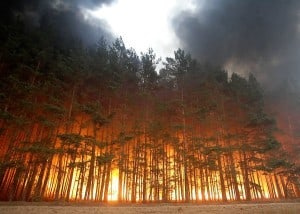
Wildfire season kicked off early this year in the Pine Barrens when a blaze broke out in Wharton State Forest on April 17.
According to the New Jersey Forest Fire Service, the Phillips Bridge wildfire had already consumed 113 acres by nightfall.
Firefighters spent the day trying to control the blaze as helicopters took water from Atsion Lake to douse the flames.
That will likely just be the beginning of the fires in the highly combustible Pinelands as the hottest, driest months are still to come.
Just last week, the area was under a “red flag warning” issued by the National Weather Service. Also known as a fire weather warning, the red flag is used to inform area firefighting and land management agencies that conditions are ideal for wildland fire combustion and rapid spread.
“Basically, the humidity will be below 30 percent and the wind gusts will be over 25 miles per hour to meet the criteria for a red flag warning to be issued here,” said John Rieth, assistant forest fire warden for Division B, one of the New Jersey Forest Fire Services’ three divisions.
Rieth said each region of the country has a different criteria because of things such as topography and vegetation.
The Pine Barrens is specifically susceptible to fast growing forest fires because of this vegetation growing underneath the pine trees.
Other areas in New Jersey and across the country contain taller trees with leaves that shade the forest floor and negate most plants from growing.
The Pinelands contain shrubs that can catch fire and spread the blaze faster than it typically does in most areas.
“Not necessarily bigger fires, I would say more rapid fires is more accurate,” Rieth said.
Unfortunately, rapid fires are the hardest to keep under control, and the surrounding environment permits this with the number of pine trees, pine needles, bark and branches in close proximity. All of these factors are referred to as “fuels” by the New Jersey Forest Fire Services.
However, the most uncontrollable fuel is the wind. Wind helps dry out the fuels more quickly — with no wind it would be harder for needles, leaves and grasses to dry fast enough between rainfalls to create any real wildfire threat.
Wind is also unpredictable in the sense that it can shift and change directions at any moment’s notice.
There is typically a sea breeze for the Pinelands region that stretches closer to the shoreline, but wind direction is never 100 percent foreseeable.
“Wind changes the direction of radiant heat,” Rieth said. “Hot air rises above the fire and the wind blows hot embers and particles ahead of the fire, producing spot fires. Eventually, multiple spot fires in a general vicinity meet and that’s what we call a ‘blow up.’”
More than half of New Jersey’s wildfires are detected by the towers dispersed throughout the state. The folks stationed in these towers conduct weather readings and will adjust their sign accordingly based on the results.
If conditions are extreme, they will set the sign to high fire danger. At this time, the service is authorized to pull from its 1,200 part-time employees to add to its staff on duty manning the fire trucks. The fire trucks, helicopters and bulldozers are all in constant contact with the towers through radios and telephone lines.
Once the fire is called in, three trucks that can hold up to 500 gallons of water each, equipment for the firefighters and a bulldozer are dispatched to the scene.
“We can dispatch proper help at the first whiff of smoke,” Rieth said.
The state protects 3.1 million acres, 122,880 of which make up Wharton State Forest.
Being that New Jersey is one of the most densely populated states in the country, fires beginning anywhere in Wharton State Forest will likely come into contact with civilization within an hour or two, whereas a forest fire in a state such as Montana can burn for days before anyone’s lives are at risk.
Residents of the Pine Barrens are encouraged by the New Jersey Forest Fire Service to protect themselves by having a clearance of little or no vegetation around their home, so if something catches fire it is not as challenging to keep from spreading to a wildfire.
The service also urges folks to use stone instead of mulch, invest in non-combustible siding and shingles, use ashtrays if smoking and to be proactive with keeping their property maintained.
If lawns are mowed, leaves are raked and trash is taken out, there are fewer fuels laying around for fires to catch onto.
“Most importantly, call 911 right away so fire suppression people can respond as quickly as possible,” Rieth said. “The faster they get there, the less damage will be done in the long run.”









